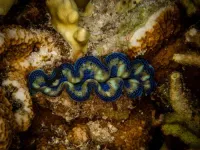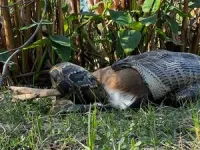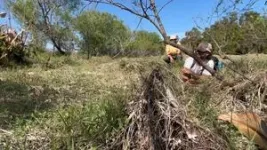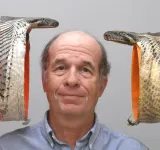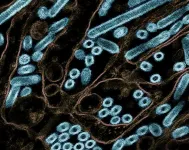(Press-News.org) The giant clam, known for its colorful cape-like mantle, wavy shell and astonishing size, is in danger of going extinct after its population plunged by more than 80% over the last century, according to a new assessment by a University of Colorado Boulder biologist and collaborators.
The assessment, led by Ruiqi Li, a postdoctoral researcher at the CU Museum of Natural History, prompted the International Union for Conservation of Nature (IUCN) today to update the conservation status of this animal from “vulnerable” to “critically endangered,” the highest level before a species becomes extinct in the wild. It also adjusted the statuses of 11 other related species, all from the group of animals known as giant clams.
Overfishing and climate change are the major threats endangering these marine invertebrates, Li said.
“Along with coral reefs, these clams provide important habitats for other creatures living in the reefs,” Li said. “They are also important nutrient producers in shallow ocean water, which is generally deprived of food. If the giant clam becomes extinct, it will have significant ecological impacts on tropical oceans.”
The IUCN announcement comes as representatives from 175 countries meet in Colombia for the 2024 United Nations Biodiversity Conference (COP16). Countries are discussing ways to stop what is known as the “sixth mass extinction,” a rapid decline in biodiversity due to human activity. The fifth mass extinction, 66 million years ago, wiped out the dinosaurs. The World Wildlife Fund estimated this month that global marine wildlife has declined by 56% since 1970.
The giant clam, or Tridacna gigas, is the best-known species of giant clams. It is the world’s largest marine bivalve mollusk, a group of invertebrate animals with two-part shells. It can grow up to 4.5 feet in length and weigh more than 700 pounds. These clams live in the shallow water of the tropical Indo-Pacific Ocean, off the coasts of Malaysia, Australia and Fiji.
Scientists are unsure how T. gigas grow so big. Similar to corals, these massive clams live in a mutually beneficial relationship with algae inside their bodies. While T. gigas provide shelter for the algae, the algae produce additional nutrients that help feed the clams.
The last time scientists assessed the T. gigas population was in 1996, when the IUCN listed the species as “vulnerable” on its Red List of Threatened Species, the global reference for assessing extinction risks for wildlife. The previous Red List version also failed to include many other giant clam species due to a lack of research.
“This is a major issue in the conservation world. People, even scientists, tend to pay more attention to mammals and birds, because they are big, cute and familiar. So there's a good chance you can find these animals on the Red List. But marine invertebrates are very neglected,” Li said.
Working with the Senckenberg Natural History Museum in Germany, Li and his collaborator, Neo Mei Lin from the National University of Singapore, collected data from previous research and biodiversity databases on all 12 giant clam species for a reassessment.
The team found that T. gigas has already become locally extinct in many regions where it used to exist, such as near Taiwan, and its overall population has declined by 84% over the past century.
In addition to updating the status of T. gigas, IUCN also upgraded other giant clam species, including Tridacna mbalavuana, or the tevoro clam, from “vulnerable” to “endangered,” as well as Hippopus hippopus, or horse's hoof clam, from “least concern” to “vulnerable.”
Li said many giant clam species have beautiful mantles—the exposed flesh that lines the shell. Even among individuals of the same species, the mantles’ color patterns vary widely, from turquoise with yellow spots to emerald green with black specks. Some resemble ink flowing through a sky blue river.
In many parts of the world, fishers harvest giant clams for food or their shells for decoration.
Climate change also poses a major threat to giant clams. When the ocean water becomes too warm, the clams expel the algae living in their tissues, similar to what happens to corals during coral bleaching. Without the algae, giant clams can starve.
The Red List update also includes some recently discovered species under the “data deficiency” category. Li said that adding these species could pave the way for future research by highlighting what is missing.
“Invertebrates, like insects and mollusks, account for more than 95% of total animal biodiversity in the world, but people are not paying enough attention to them. There’re still a lot of undiscovered or undescribed species out there,” Li said.
While the IUCN Red List has no legal implications, efforts to protect giant clams are growing. In July, the National Oceanic and Atmospheric Administration (NOAA) proposed listing 10 giant clam species —including T. gigas—under the Endangered Species Act. If approved, these giant clams will receive legal protection in the U.S., barring harvesting and trade of wild individuals. Li has submitted his assessment to NOAA in support of this effort.
“As a biologist, I'm working on translating findings from my research into policy changes, but not enough biologists are doing this. I hope to encourage more biologists to devote time into population assessment and conservation,” Li said.
END
Giant clam declared critically endangered after the latest assessment
2024-10-28
ELSE PRESS RELEASES FROM THIS DATE:
DOE awards $12 million to expand marine energy initiatives at Lehigh and partner universities
2024-10-28
The U.S. Department of Energy (DOE) recently granted the Atlantic Marine Energy Center (AMEC) $12 million to expand research and development in marine energy initiatives. AMEC comprises four universities including the University of New Hampshire, Stony Brook University, the Coastal Studies Institute, and Lehigh University.
In total, DOE’s Water Power Technologies Office invested more than $41 million in this latest round of funding using the Bipartisan Infrastructure Law (BIL) to four university-led National Marine Energy Centers located across the country. The centers will use the funds to support research, infrastructure improvements, strategy, administration, outreach, ...
Pythons can swallow even bigger prey than scientists realized
2024-10-28
Burmese pythons can consume prey even larger than scientists realized, according to a new study.
That means more animals are on the menu across southern Florida, where the nonnative, invasive snakes have decimated populations of foxes, bobcats, raccoons and other animals.
Pythons swallow deer, alligators and other prey whole. What they eat is limited in part by how big an animal they can wrap their flexible, stretchy jaws around. Researchers call this the snake’s gape.
University of Cincinnati Professor Bruce Jayne said measurements of snakes captured in and around Everglades National Park show that the biggest pythons have an even bigger gape than mathematical ...
Evidence mounts for dark energy from black holes
2024-10-28
Image
Almost 14 billion years ago, at the very beginning of the Big Bang, a mysterious energy drove an exponential expansion of the infant universe and produced all known matter, according to the prevailing inflationary universe theory.
That ancient energy shared key features of the current universe's dark energy, which is the largest mystery of our time by at least one objective standard: It makes up the majority—roughly 70%—of the universe, but scientists ...
AI might scare us, but can we scare it?
2024-10-28
In recent years, advancements in artificial intelligence have enabled intelligent machines to generate visual art, compose music, and create videos. They converse with us, help with homework, and have even begun competing for our jobs. Amid these advances, machines evoke powerful reactions from humans—sparking concerns about control, fairness, and the potential for misuse. Many feel unsettled by the growing presence of intelligent machines when they inadvertently reinforce power imbalances and perpetuate injustices.
Amid all of this disruption and mistrust, we are comforted to know that machines can`t have emotions. Yet, recent advancements in language-based AI have demonstrated ...
Early intervention in patients with asymptomatic severe aortic stenosis and myocardial fibrosis
2024-10-28
About The Study: In asymptomatic patients with severe aortic stenosis and myocardial fibrosis, early aortic valve intervention had no demonstrable effect on all-cause death or unplanned aortic stenosis–related hospitalization. The trial had a wide 95% CI around the primary end point, with further research needed to confirm these findings.
Corresponding Author: To contact the corresponding author, Marc R. Dweck, PhD, email marc.dweck@ed.ac.uk.
To access the embargoed study: Visit our For ...
Rutgers receives $3.3 million federal grant to recruit counselors for high-need schools
2024-10-28
Rutgers University’s Graduate School of Education (GSE) has received a $3.3 million grant to increase the number and diversity of highly trained school counselors to help fill the gap in mental health services in New Jersey high-need school districts.
The Mental Health Service Professional Demonstration grant from the U.S. Department of Education – part of a federal initiative to expand nationwide student access to school-based mental health services – will fund the GSE-led School Counseling Prevention to Intervention project.
“School counseling is often a misunderstood and under-resourced profession,” said Ian Levy, an assistant professor of school counseling ...
Bovine H5N1 influenza from infected worker transmissible and lethal in animal models
2024-10-28
WHAT:
A highly pathogenic avian influenza (HPAI) H5N1 virus, isolated from the eye of a farm worker who became infected through contact with dairy cows, was lethal in mice and ferrets infected in a high-containment laboratory environment, according to a new study in Nature. The study investigators also found that the virus isolated from the worker, who experienced mild inflammation of the cornea (conjunctivitis), could be transmitted through the air between separated ferrets and might be capable of binding to and replicating in human respiratory tract cells.
The virus isolated from the worker is called huTX37-H5N1 and has a mutation (PB2-E627K) frequently seen in avian influenza viruses ...
Marzougui & Kan receive funding for crash testing
2024-10-28
Dhafer Marzougui, Associate Professor, Physics and Astronomy, College of Science, and Cing-Dao Kan, Professor/Director, Center for Collision Safety and Analysis, College of Science, received funding for: “NCHRP Project 03-110-01.”
Marzougui and Kan aim to identify and evaluate the crash performance of breakaway sign and luminaire supports and crashworthy work-zone traffic control devices that are non-proprietary and commonly used.
The researchers will examine in-service safety performance, potential failure modes (and, if possible, design modifications that might address ...
Global leaders in the fight against cancer gathered in Washington, DC on October 18, 2024, for the NFCR Global Summit and Award Ceremonies for Cancer Research & Entrepreneurship
2024-10-28
Washington, DC – The 2024 National Foundation for Cancer Research (NFCR) Global Summit and Award Ceremonies for Cancer Research & Entrepreneurship, co-hosted with the AIM-HI Accelerator Fund, convened the world’s top experts across cancer research, biotech entrepreneurship, pharmaceuticals, investment, and patient advocacy. This prestigious event, held at the National Press Club, served as a unique forum for advancing groundbreaking science, fostering innovative collaborations, identifying ...
New research highlights economic and employment challenges for parents of medically complex babies
2024-10-28
Parents with babies born preterm or with low birth weight face significant economic and employment challenges, according to new research published in JAMA Pediatrics.
The study, led by Erin Von Klein, MD, a neonatology fellow at Monroe Carell Jr. Children’s Hospital at Vanderbilt, reveals that 30% of parents with a very low birth weight baby (under 1,500 grams or 3.3 pounds) have had to make an employment decision based on their child’s health and the required ongoing care after discharge from the neonatal intensive care unit.
"The lower the child's birth weight, the more likely a parent was to make one of these decisions," said Von Klein. "Of parents with ...
